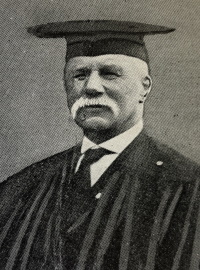

Graham Cox Campbell (9 November 1847–2 December 1915), Presbyterian missionary and educator, was born in Middle Stewiacke, Colchester County, Nova Scotia, the son of Henry M. Campbell and Eleanor C. Rutherford Campbell. Little is recorded about his life until 1869, when he immigrated to the United States. Campbell received a B.A. from the University of Minnesota in 1877 and an M.A. from the same institution in 1880. In the latter year he also graduated from Auburn Theological Seminary in New York and was ordained by the Presbytery of Saint Paul. On 17 August 1880 Campbell married Laura A. Kreis, of Monticello, Minnesota. They had three sons and two daughters.
Campbell and his wife embarked on careers as missionaries soon after their marriage. The Board of Foreign Missions of the Presbyterian Church in the U.S.A. assigned them to the mission at Baraka on the Gabon River in West Africa, which they reached in January 1881. Campbell had responsibility for the boys' school at the mission, was superintendent of the Sunday school, preached every other Sunday, and in December of that year became treasurer for the mission. A severe illness in 1883 forced him to return to the United States to recuperate. After resuming his work on the Gabon, Campbell was stricken with a near-fatal fever and forced to end his career as a foreign missionary. He returned home, and by May 1887 the mission board had accepted his resignation.
For the next three years Campbell worked in Arkansas as a school superintendent for the Presbyterian Board of Missions for Freedmen. In 1890 the board sent him to Virginia as president of Ingleside Seminary, one of three educational institutions for African American girls that the board sponsored in the South. A tuition-free school in Amelia County, Ingleside had its roots in the earliest attempt by the northern Presbyterian Church to educate southern blacks. In 1864 Samantha Jane Neil had started a school for children and adults under a large oak tree in Amelia Court House. When Campbell arrived the need for a larger school to accommodate the many girls seeking an education at Ingleside was evident. In 1891 the board began construction of a new facility in Burkeville, which had the advantage of being at the junction of the Norfolk and Western Railroad and the Richmond and Danville Railroad. The new Ingleside Seminary opened in October 1892 with ninety students.
Girls from as far away as New Jersey and New York undertook a five-year program of Bible studies, a liberal-arts curriculum including American history, English literature, languages, mathematics, and music, and practical classes in cooking, housekeeping, and sewing. The Presbyterian Church emphasized the evangelical nature of its schools but realized that religious instruction was more valuable when combined with a strong education. On 23 May 1906 a fire destroyed Ingleside, but the missions board built a new and larger brick school, which opened in October 1907. By 1914 Campbell's dedication to offering quality education had won the institution accreditation from the Virginia State Board of Education, which meant that the school's graduates could receive teaching certificates without taking an examination. Ingleside then had a faculty of about fifteen and more than one hundred students.
On the evening of 2 December 1915 Campbell and two students entered an outbuilding to inspect the malfunctioning acetylene gas plant used for lighting the school. One of the students carried a lantern, which ignited the gas and caused an explosion. Graham Cox Campbell and the student carrying the lantern were killed. He was buried in a Burkeville cemetery, but his name was later included on his widow's headstone at Ridgelawn Memorial Park, in Cabell County, West Virginia, where she later lived. Campbell's widow served as acting superintendent until the board appointed a successor. Ingleside Seminary continued operating until the 1930s, when the Great Depression forced many northern churches to eliminate their schools in the South.
Sources Consulted:
Edgar Sutton Robinson, ed., The Ministerial Directory of the Ministers in "The Presbyterian Church in the United States" (Southern), and in "The Presbyterian Church in the United States of America" (Northern) (1898), 1:199; marriage verified by Office of County Auditor-Treasurer, Wright Co., Minn.; Board of Foreign Missions of the Presbyterian Church in the U.S.A., Annual Reports (1881–1887); Woman's Work for Woman: A Union Magazine 12 (1882): 121–122, 182–183; Ingleside Seminary Catalogues, 1892/1894, 1897/1898, 1913/1916; seminary mentioned often in church and missionary publications, esp. Assembly Herald, Church at Home and Abroad, and Home Mission Monthly; United States Census Schedules, Nottoway Co., 1900, 1910, Records of the Bureau of the Census, Record Group 29, National Archives and Records Administration, Washington, D.C.; birth date in Death Certificate, Nottoway Co., Bureau of Vital Statistics, Commonwealth of Virginia Department of Health, Record Group 36, Library of Virginia; obituaries in Richmond Planet, 4 Dec. 1915, and Farmville Herald, 10 Dec. 1915; memorial in Assembly Herald 22 (1916): 410; account of explosion and memorial in Ingleside Seminary, Catalog (1913/1916), 37–38, 39–40 (portrait on 8).
Image courtesy of Library of Virginia.
Written for the Dictionary of Virginia Biography by Marianne E. Julienne.
How to cite this page:
Marianne E. Julienne, "Graham Cox Campbell (1847–1915)," Dictionary of Virginia Biography, Library of Virginia (1998– ), published 2001, rev. 2022 (http://www.lva.virginia.gov/public/dvb/bio.asp?b=Campbell_Graham_Cox, accessed [today's date]).
Return to the Dictionary of Virginia Biography Search page.


